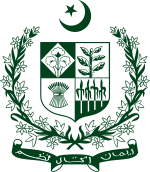
Back دستور باكستان Arabic পাকিস্তানের সংবিধান Bengali/Bangla Verfassung der Islamischen Republik Pakistan German Konstitucio de Pakistano Esperanto قانون اساسی پاکستان Persian Constitution du Pakistan French पाकिस्तान का संविधान Hindi Konstitusi Pakistan ID Costituzione del Pakistan Italian Perlembagaan Pakistan Malay
| Constitution of the Islamic Republic of Pakistan | |
|---|---|
 | |
| Overview | |
| Jurisdiction | |
| Created | 20 October 1972 |
| Ratified | 10 April 1973[1] |
| Date effective | 14 August 1973 |
| System | Federal Parliamentary Constitutional Republic |
| Government structure | |
| Branches | Three (Executive, Legislature and Judiciary) |
| Head of state | President of Pakistan |
| Chambers | Bicameral (Senate and National Assembly) |
| Executive | Prime minister–led cabinet responsible to the lower house of the parliament |
| Judiciary | Supreme court, high courts and district courts |
| Federalism | Federation |
| Electoral college | Yes, for presidential elections |
| History | |
| Amendments | 26 |
| Last amended | 31 May 2018 |
| Location | Parliament House, Islamabad, Pakistan |
| Commissioned by | Parliament of Pakistan |
| Signatories | 5th Parliament (145 out of 150 members) |
| Supersedes | Constitution of Pakistan, 1962 Legal Framework Order, 1970 |
The Constitution of Pakistan (Urdu: آئینِ پاکستان ; ISO: Āīn-ē-Pākistān), also known as the 1973 Constitution, is the supreme law of Pakistan. The document guides Pakistan's law, political culture, and system. It sets out the state's outline, the fundamental rights of the population, the state's law and orders, and also the structure and establishment of the institutions and the armed forces.[2] Drafted by the government of Zulfikar Ali Bhutto, with additional assistance from the country's opposition parties, it was unanimously approved by the 5th Parliament on 10 April and ratified on 14 August 1973.[3][4] The first three chapters establish the rules, mandate, and separate powers of the three branches of the government: a bicameral legislature; an executive branch governed by the Prime Minister as chief executive; and an apex federal judiciary headed by Supreme Court.[4] The Constitution designates the President of Pakistan as a ceremonial Head of State who is to represent the unity of the state.[5] The first six articles of the constitution outline the political system as federal parliamentary republic system; as well as Islam as its state religion.[6] The Constitution also encapsulates provisions stipulating the legal system's compliance with Islamic injunctions contained in the Quran and Sunnah.Cite error: A <ref> tag is missing the closing </ref> (see the help page). The 1962 constitution was suspended in 1969 and abrogated in 1972.[7]
The 1973 constitution was the first in Pakistan to be framed by elected representatives. Unlike the 1962 constitution it gave Pakistan a parliamentary democracy with executive power concentrated in the office of the prime minister, and the formal head of state—the president—limited to acting on the advice of the prime minister.[8]
The Constitution states that all laws are to conform with the injunctions of Islam as laid down in the Quran and Sunnah.[9] The 1973 Constitution also created certain institutions such as the Shariat Court and the Council of Islamic Ideology to channel the interpretation and application of Islam.[10]
After another coup d'état in 1977, the constitution was held in abeyance until it was "restored" in 1985 but with an amendment (the Eighth) shifting power from the parliament and Prime Minister to the president. Another Amendment (Seventeenth) in 2004 continued this shift, but in 2010, the Eighteenth amendment reduced presidential powers, returning the government to a parliamentary republic.[citation needed]
- ^ "Golden Jubilee celebrations of 1973 Constitution start today". 10 April 2023.
- ^ Abiad, Nisrine (2008). Sharia, Muslim states and international human rights treaty obligations : a comparative study. London: British Institute of International and Comparative Law. pp. 96–200. ISBN 978-1-905221-41-7.
- ^ Enterprise Team (1 June 2003). "The Constitution of 1973'". The Story of Pakistan. Archived from the original on 2 October 2013. Retrieved 15 October 2011.
- ^ a b Constitution of Pakistan. "Constitution of Pakistan". Constitution of Pakistan. Archived from the original on 12 July 2011. Retrieved 22 January 2013.
- ^ "Part III. The Federation of Pakistan: Chapter 1; The President". Const. of Pakistan. Archived from the original on 7 April 2011. Retrieved 22 January 2013.
- ^ "First Six Articles". Archived from the original on 21 May 2013.
- ^ Islamization of Laws and Economy, Case Studies on Pakistan by Charles Kennedy (Institute of Policy Studies, The Islamic Foundation, 1996, p.85)
- ^ Cite error: The named reference
cfrwas invoked but never defined (see the help page). - ^ Cite error: The named reference
:8was invoked but never defined (see the help page). - ^ Diamantides, Marinos; Gearey, Adam (2011). Islam, Law and Identity. Routledge. p. 198. ISBN 978-1-136-67565-2.
The 1973 constitution also created certain institutions to channel the application and interpretation of Islam: the Council of Islamic Ideology and the Shariat Court.
© MMXXIII Rich X Search. We shall prevail. All rights reserved. Rich X Search